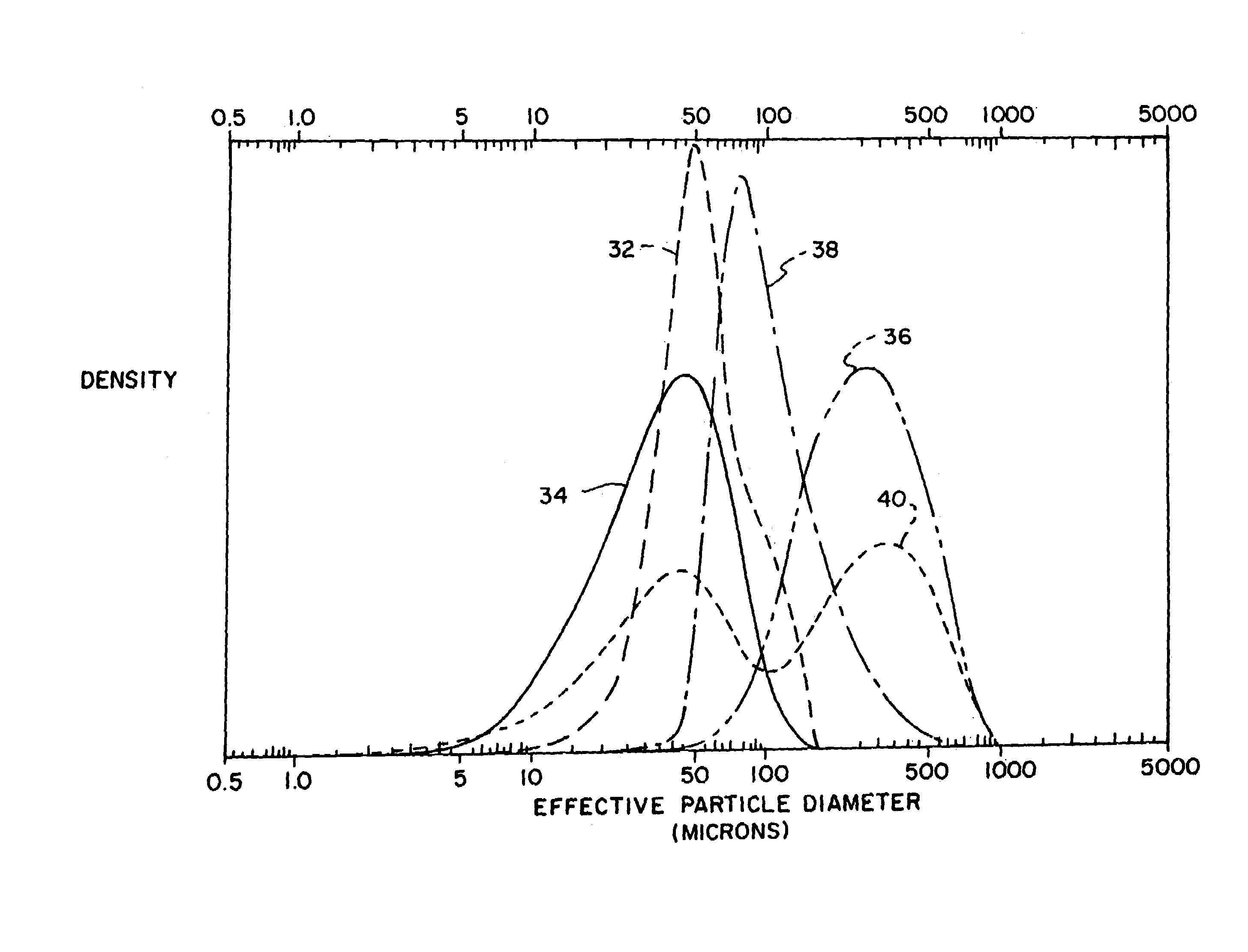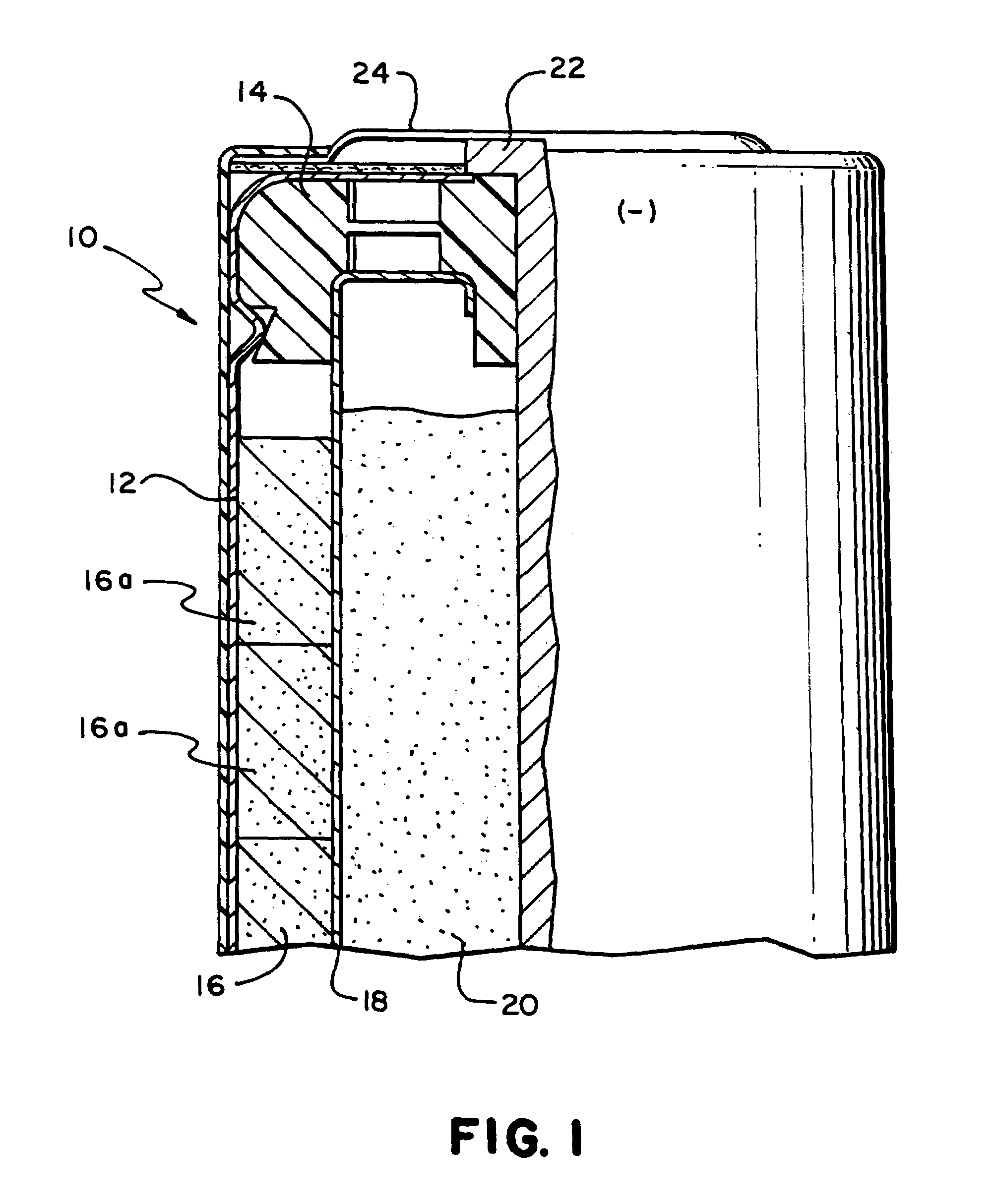Electrode having modal distribution of zinc-based particles
a zinc-based particle and electrochemical technology, applied in the direction of fuel and primary cells, cell components, transportation and packaging, etc., can solve the problems of inability to keep up with the current draw rate, the reaction cannot keep up with the overall capacity of the battery, and the voltage is unacceptable, so as to achieve good cell performance characteristics and high discharge rate performance
- Summary
- Abstract
- Description
- Claims
- Application Information
AI Technical Summary
Benefits of technology
Problems solved by technology
Method used
Image
Examples
example 1
[0077]Cylindrical alkaline batteries of Type AA were built with gel anodes having the following two compositions to test the effect of zinc-based particles in the form of fines (the composition values listed are in percent by weight):
[0078]
Composition1A1BZinc alloy particles67.9767.97Indium acetate0.030.03(42% Indium)Phosphate ester0.060.06(6% concentration)Polyacrylic acid0.530.53Sodium polyacrylate0.380.38Acetic acid0.090.09(2.5% concentration)Electrolyte solution30.9430.94(2% ZnO, 35% KOH)Total:100.00100.00Particle sieve size−20 / +200−200Average particle size335 microns86 microns
[0079]The above compositions were prepared by first mixing the indium acetate powder with the dry zinc alloy particles. Next, the acetic acid and phosphate ester were applied, followed by the polyacrylic acid and sodium polyacrylate. After blending and crushing any lumps, the electrolyte solution was added and the mixture was blended until uniform. The zinc alloy particles in both 1A and 1B included 150 pp...
example 2
[0082]Cylindrical alkaline batteries of Type AA were built with gel anodes having the following two compositions (the composition values listed are in percent by weight):
[0083]
Composition2A2B2CZinc alloy particles69.80169.80269.803Indium acetate0.040.040.04(42% Indium)Phosphate ester0.060.060.06(6% concentration)Polyacrylic acid0.510.450.45(Carbopol 940)Acetic acid1.121.121.12(2.5% concentration)Electrolyte solution28.4728.5328.53(2% ZnO, 35% KOH)Total:100.00100.00100.001Alloy includes 150 ppm In, 200 ppm Bi; particles sieved to −20 / +200 mesh size (average particle size of 354 micron; distribution 36, FIG. 2)2Alloy includes 150 ppm In, 200 ppm Bi; particles sieved to −325 mesh size (average particle size of 57 micron; distribution 32, FIG. 2).3An equal mixture, by weight, of particles as in 2A and gas atomized zinc particles alloyed with 500 ppm In and 500 ppm Bi. The gas atomized particles had a average particle size of about 41 micron (distribution 34, FIG. 2). The particle mixtur...
example 3
[0086]Cylindrical alkaline batteries of Type AA were built with gel anodes having the following two compositions to test the effect of zinc-based particles in the form of fines (the composition values listed are in percent by weight):
[0087]
Composition3A3BZinc alloy particles70.0070.00Indium acetate0.030.03(42% Indium)Phosphate ester0.060.06(6% concentration)Polyacrylic acid0.510.48(Carbopol 940)Acetic acid0.110.11(2% concentration)Electrolyte solution29.2929.32(2% ZnO, 35% KOH)Total:100.00100.00Average particle size298 microns112 microns
[0088]The above compositions were prepared by first mixing the indium acetate powder with the dry zinc alloy particles. The electrolyte solution was mixed with the polyacrylic acid to form a gel. After blending and crushing any lumps, the gel was added to the indium acetate / zinc alloy combination and the resulting mixture was blended until uniform.
[0089]The zinc alloy in 3A included 150 ppm In and 200 ppm Bi.
[0090]3B was a mixture of 6 weight percent...
PUM
| Property | Measurement | Unit |
|---|---|---|
| particle size diameter distribution | aaaaa | aaaaa |
| particle size diameter distribution | aaaaa | aaaaa |
| particle size | aaaaa | aaaaa |
Abstract
Description
Claims
Application Information
 Login to View More
Login to View More - R&D
- Intellectual Property
- Life Sciences
- Materials
- Tech Scout
- Unparalleled Data Quality
- Higher Quality Content
- 60% Fewer Hallucinations
Browse by: Latest US Patents, China's latest patents, Technical Efficacy Thesaurus, Application Domain, Technology Topic, Popular Technical Reports.
© 2025 PatSnap. All rights reserved.Legal|Privacy policy|Modern Slavery Act Transparency Statement|Sitemap|About US| Contact US: help@patsnap.com



